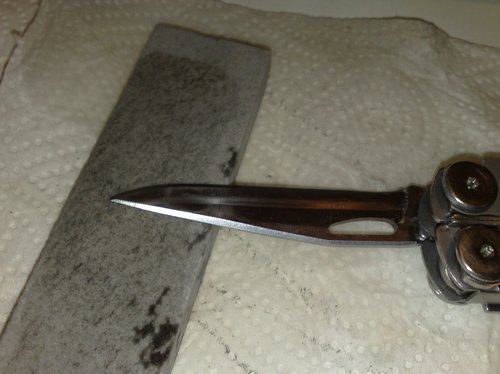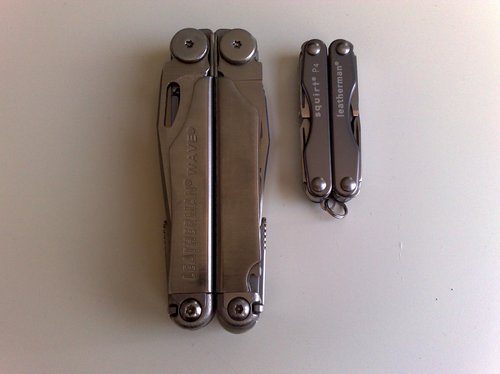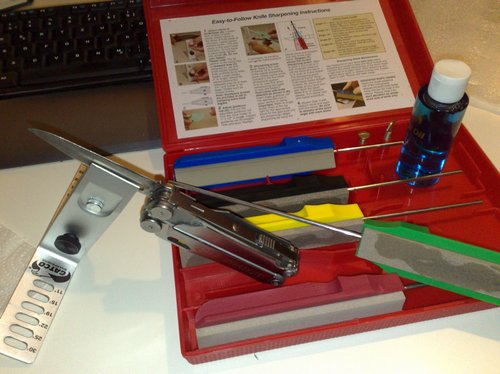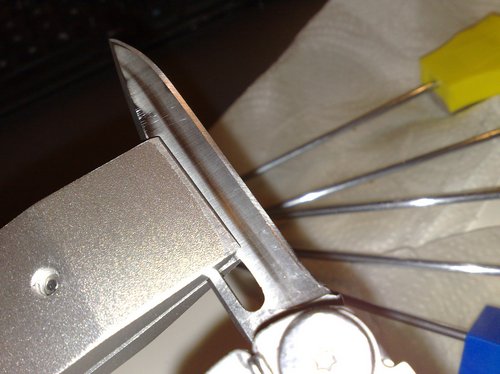I assume that about 99% of all knives and pangas sold in Kenya are Made in China. The remaining 1% are probably imported kitchen knives and/or multitools from the US and Europe.
Everyone who owns a knife probably knows that a dull/blunt knife is almost useless, so there’s a knife sharpening service available in most places like this one we’ve featured over at AfriGadget some time ago.
I also bought one of these rotating grinding stones from Uchumi (ex-supermarket chain in Kenya) many years ago (for Kshs. 265/=, actually) and have also been tempted to get one of these huge sharpening stones / hones for kitchen knives which also sold for something like 70 bob back in the days (they are much more expensive in Europe, btw – even though they are all Made in China). Sharpening a panga (machete) with a rotating grinding stone is “ok” – for kitchen knives the flat grinding stone (~ hone) is the better (and often only) alternative as you want to keep the angle of the edge.
This edge angle actually is the most important part on a knife, I think, at least when it comes to its sharpness.
Cheap and lazy as I am, I have in the past only used sharpening stones and other – cheap – sharpening tools that MAY work for the ordinary kitchen knife, but should NEVER be used on a hunting knife, or – in my case – a multitool.

Arkansas oil-stone
Just in case you didn’t know: the sharpening process itself is a peculiar task on which you’ll find various – dedicated – websites and forums that solely talk about how to best sharpen a knife. As far as I know, using a sharpening stone (with water or oil, sometimes also some polishing paste) is the best way to sharpen a knife. This, however, requires some basic knowledge on steel, how knives are usually made, what kind of steel was used on your knife and how this steel will behave under higher temperatures. Those Japanese kitchen knives (we have one at home from back in the days) for example are very sensitive to higher temperatures above ~ 160°C (of course, again, depending on the steel mixture it is made of), so you absolutely have to make sure the hone is cooled down and soaked in water anyways. The majority of all other knives in our kitchen are Made in Germany, which means they are not as sensitive as the Japanese kitchen knives and also keep their sharpness to some extent. They aren’t as cheaply made as the ones from China as I am yet to see a decent knife from China. My sister actually gave me a set of 5 really good kitchen knives from Zwilling, Germany, as a present during last christmas, and I have to admit that cooking really is a joy with these new knives. Good tools are a blessing!

As mentioned, I am a Multitool guy. I have four Leatherman multitools (the Wave I, Wave II, Charge TTi and a small Squirt P4). You won’t buy these tools for their knives because, well, the steel used on their blades isn’t that great (except for the Charge TTi which comes with an S30V blade).
The blade on my Wave II lasted about four years until it became too dull. Stupid and unknowing as I am, I of course only tried the usual tools (Victorinox Sharpening Pen = horrible, knife sharpener from the kitchen, Arkansas sharpening stone) – thereby killing the edge angle on the knife.
Left with an unability to really sharpen my multitool to a decent level, I brought it to a “professional” shop – a very popular gun & knives shop in Frankfurt downtown. For some unknown reasons, these jerks completely fucked it up, killing the edge angle even more and returning a somehow sharp knife that looked like being sharpened on a high speed sharpening wheel. That’s exactly what I had tried to avoid on my Multitool, so I backed off and told myself: Argh….maybe next time. This was half a year ago.
Ok, so I may be too German on this, but there’s this moment when things just have to be perfect. You either do it right or never. So I ended up buying this GATCO Edgemate Professional Knife Sharpening System for a hefty EUR 47.95 today any idiot like me can use to regain the much needed edge angle on a blade. The guiding rods attached to the hones are inserted into the holes on the clamp and will then glide over the edge at a constant angle. Sounds too complicated? Here’s a video on it…

And you know what? These four different hones on a guidance rod just work and allow you to set an edge angle of 11°, 15°, 19°, 22°, 25° and 30°. There also is a fifth rod for serrated knives – my multitool also has a serrated blade. I’ve been able to restore the angle on my multitool and also sharpened a really dull kitchen knife with great success. I understand that this set isn’t meant to deliver razor blade sharpness (which would probably require another hone with even finer grit and/or paste and some leather) but for everything else – and especially for hunting knives – this set is the best idiot-proof choice. Something like EUR 50 are a lot of money just for sharpening a knife, but I believe that it is well invested money that will enable me to enjoy sharp knives and send all other useless sharpening devices into early retirement.

The blade on my Wave II during the sharpening process. The – still rough – 25° edge angle is already visible (all pics taken with a Nokia N95, btw).
UPDATE: I just received a call by the main Leatherman dealer/importer in Germany who asked about the knife on my Wave II and offered a free sharpening. Amazing! Told them I’d be glad to accept this offer and will send in mine asap the become blunt again.

Only JKE:-) What an elaborate way to describe sharpening a knife. I didn’t know it is such a technical subject. Dude you are interesting – in a good way. I remember back in Kenya in late 90s , there used to be a Mzee who would come around the “Estate” to sharpen our knives for a small fee every month and for some weird reason, those knives stayed sharpened for a longer period than do-it-yourself. A noble way to make a little cash.
This tip of keeping knives sharp should come in hardy during Xmas Goat slaughtering season :-)
On knife sharpening excellent writeup ..and my take
http://www.youtube.com/watch?v=txyXUXWybt4&feature=channel_page
regards
@Zenrainman- that is exactly the tool of trade the old man used in my neighborhood
Eh, it is a similar machine to the one featured on AfriGadget http://www.afrigadget.com/2007/06/21/the-knife-sharpening-bicycle/.
Mamkes me wonder where this design & setup coms from? But anyways, these stones are very rough and only good for machetes. Any (flat) hone (also from China) will deliver better results. These rotating wheels are just quicker but also much more abrasive.
@Zenrainman: you’re using a flip cam? I’ve been wondering about the video quality which is superb I think!
Glad to hear about the knife sharpening bicycle device being the same …and yup its a Flip and Flipping is a nice hobby..
Is there the Persian Wheel then in Africa ? which parts?
http://www.youtube.com/watch?v=29wG7-8gOI4
regards
Hi Vish, the only water wheel I can think of is Peter Morgan’s version from back in the days: http://lurkertech.com/water/pump/morgan/blair/
Great job in this post! I found it quite informative. I’ve bookmarked your website and I am positive that I’ll come back many more times in future.